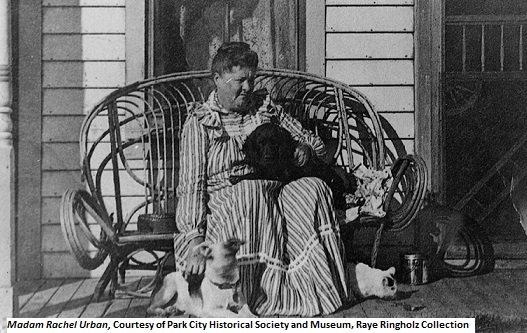Dublin Core
Title
Description
It may come as a surprise to learn that in late 19th century Utah – an era with great constraints on women’s work – that prostitution offered at least some women a path to a powerful career.
In the late 1800s, railroads and urban growth spurred the development of red light districts throughout many of Utah’s cities – both large and small. Although prostitution was illegal, most police officers and local governments turned a blind eye, and madams – the women who owned brothels – leveraged the economic demand for their services to gain social and political power within their communities.
Madams were savvy business owners who earned a lot of money at a time when high-paying jobs for women were few and far between. Madams sought to bring in reliable workers, and many operated brothels in more than one town. The secret and illicit nature of their trade, along with the number of men who frequented their brothels, meant that, in exchange for silence about their many clients, madams wielded influence that kept their businesses open.
Ice cream parlors were common recruiting places for new workers, although most madams denied luring young girls into a life of crime. In fact, many madams were picky about the behavior and appearance of their workers, and ran a tight ship. Rachel Urban in Park City, for example, demanded that her employees be educated and cultured, and did not allow them to walk the street. If her workers broke the rules, she bought them a one-way ticket out of town.
Despite lax law enforcement, many prostitutes still risked violence, disease, and arrest. What’s more, they often took the blame for these dangers of the workplace. Some madams invested heavily in the safety of their workforce. Belle London, for example, spent nearly $500,000 to build The Stockade, a heavily-guarded facility where she conducted business in downtown Salt Lake City. London planned a hospital there, with the aim of keeping her workers healthy.
Lenient attitudes toward prostitution did not survive the Progressive Era of the early 1900s. Many of Utah’s powerful madams were arrested or died, and their brothels shut down. Nonetheless, their legacy lives on in the stories and myths that surround the fabled red light districts of Utah.
Creator
Mikee Ferran for Utah Humanities © 2018
Source
Image: Madam Rachel Urban. Urban sitting on the porch of her home in Park City. Park City Historical Society and Museum, Raye Ringholz Collection.
_______________
See Val Holley, 25th Street Confidential: Drama, Decadence, and Dissipation along Ogden’s Rowdiest Road (Salt Lake City: University of Utah Press, 2013); ChristyKarras, More than Petticoats: Remarkable Utah Women (Globe Pequot Press: 2010); Utah’s History to Go “The Oldest Profession’s Sordid Past in Utah” and “History of the Stockade and Salt Lake’s Red Light District”; for information about Belle London see Historic25’s article; for information on Ogden see “Historian says 25th Street’s notorious reputation more about religion than prostitutes,” Standard-Examiner, March 6, 2014; for information on Farmington brothel see “Looking Back at Farmington’s Short-Lived Brothel,” Davis Clipper, January 22, 2014; and for information on Rachel Urban see “Park City’s Red Light District,” Park Record, March 22, 2016.

